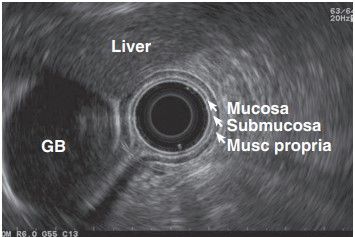
Endoscopic Ultrasonography in the Stomach: Precision in Gastric Imaging
Explore the significance of Endoscopic Ultrasonography (EUS) in gastric imaging, focusing on the techniques that enhance accuracy in evaluating stomach lesions and perigastric space.
Endoscopic Ultrasonography: A Key Tool in Gastric Imaging
Endoscopic Ultrasonography (EUS) plays a vital role in evaluating gastric conditions, offering a detailed view of the stomach’s layers and the surrounding area. Its precision is paramount in diagnosing and managing various gastric issues.
Two Techniques for Enhanced Gastric Imaging
EUS employs two techniques using standard echoendoscopes, each tailored for specific situations:
- Standard Echoendoscopes for Larger Lesions and Global Imaging: Ideal for evaluating lesions larger than 2 cm, standard echoendoscopes are crucial in global stomach imaging and assessing the perigastric space.
- Catheter Probes with Dual-Channel Endoscopes for Smaller Lesions: When imaging smaller lesions, where simultaneous endoscopic and ultrasound views are beneficial, catheter probes used in conjunction with dual-channel endoscopes offer superior results.
Importance of Technique in Accurate Imaging
Accurate gastric imaging with EUS hinges on the correct application of these techniques. The choice of method significantly impacts the quality of the imaging and, consequently, the accuracy of diagnosis and treatment planning.
Evaluating Large Gastric Lesions
For large gastric lesions, standard echoendoscopes provide comprehensive imaging. They allow for an extensive assessment, crucial for understanding the lesion’s nature and its relationship with surrounding tissues.
Imaging Small Lesions and the Perigastric Space
Small lesions require detailed imaging to ascertain their characteristics and potential impact. The combination of catheter probes and dual-channel endoscopes facilitates this, offering a dual perspective that enhances diagnostic precision.
Assessing the Perigastric Space
EUS is particularly effective in evaluating the perigastric space, providing insights into the spread of gastric conditions and helping to stage gastric cancers accurately.


Conclusion
Endoscopic Ultrasonography has revolutionized gastric imaging. Its ability to provide detailed and accurate views of both large and small lesions, as well as the perigastric space, is indispensable in the diagnosis and management of gastric conditions. The careful selection of imaging techniques based on the lesion size and location is critical to the success of EUS in clinical practice.
Disclaimer: This content is for informational purposes only and should not be considered as medical advice. Always consult a healthcare professional for personal medical advice.
Learn More About Our Gastroenterology Services
Contact Us for More Information
